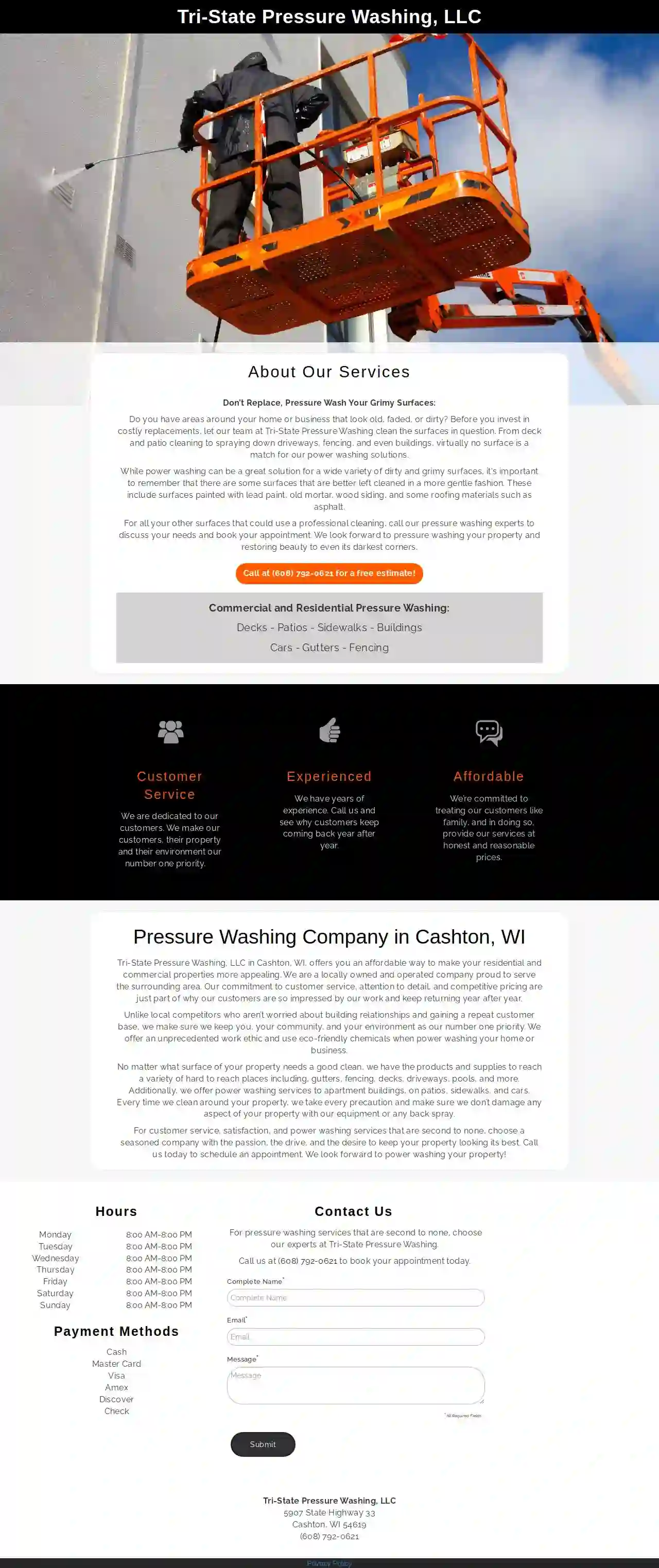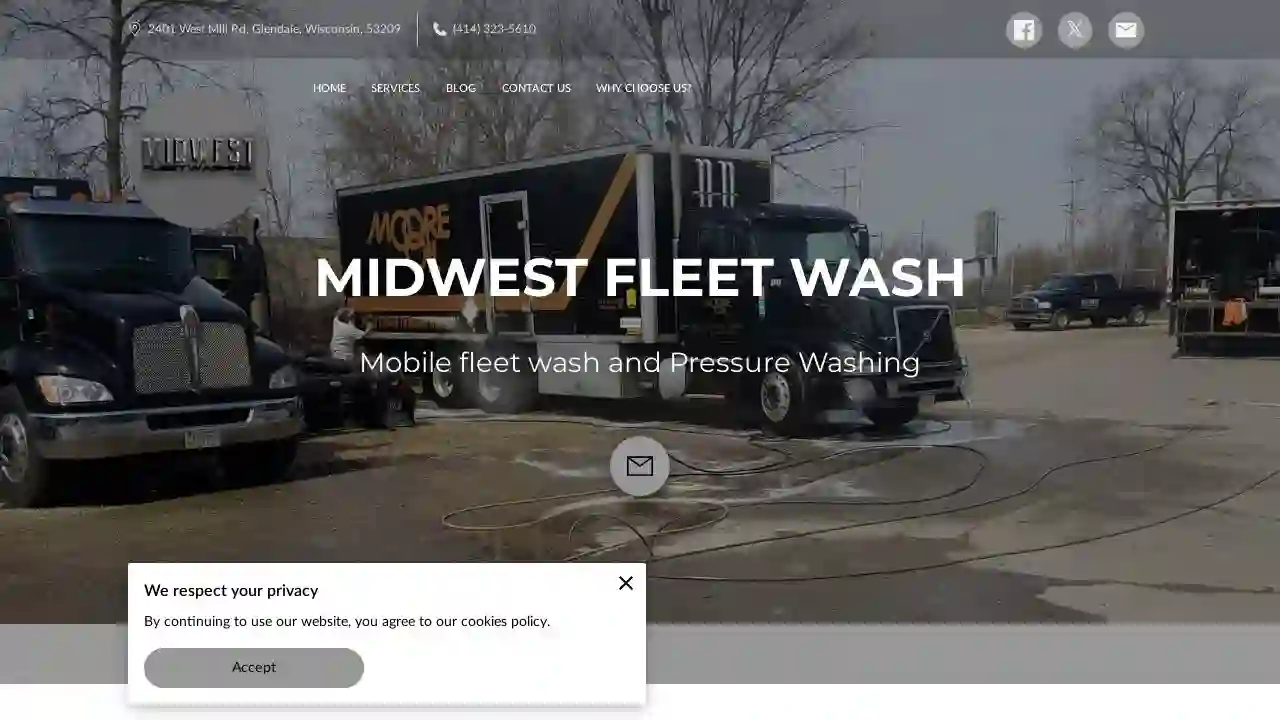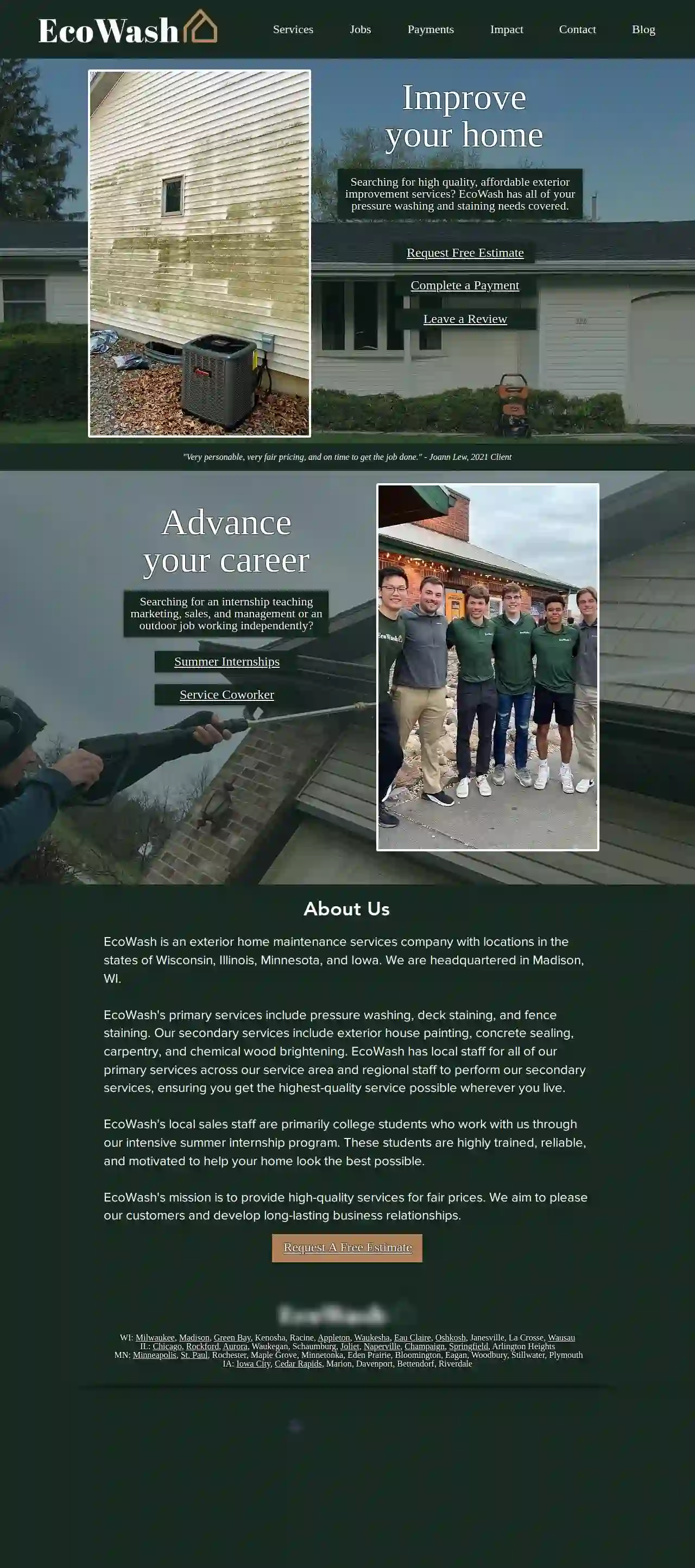Pressure Washing Fitchburg
Find Deck and Fence Cleaning in Fitchburg
Get up to 3 Pressure Washing quotes for your project today! Compare profiles, reviews, accreditations, portfolio, etc... and choose the best service.

Pressure Wash 360 - Pressure Washing Co.
52 reviewsEAU CLAIRE, Eau Claire, 54701, USPressure Wash 360 is the #1 source for professional pressure washing, power washing, deck cleaning, building pressure washing, TPO and PVC rubber roof cleaning, and lake home washing in the Chippewa Valley! We have over 20 years of pressure washing restoration solutions. Pressure Wash 360 is not just another pressure washing and pressure cleaning company. We pride ourselves on being the industry leader in fire damage restoration, TPO and PVC rubber roof cleaning, building washing, house washing, lake and log home siding cleaning, deck cleaning, gutter cleaning, ice damming, concrete cleaning, and historical stone restoration. We will provide to our clients first-class pressure washing solutions with an emphasis on servicing it right the first time. We provide the very best customer service experience of anyone in the service industry. Need Pressure Washing Services?
- Services
- Why Us?
- Gallery
Get Quote
Pressure Pro Exteriors
578 reviewsWest Bend, WI, 4916 Cal Dr., 53095, USCelebrating our 7th year of providing the best exterior cleaning services in West Bend, WI. We offer Window Cleaning, Pressure Washing, gutter Cleaning, Ice dam removal & More! We understand the stress of hiring a cleaning company. Let us show you how easy it is! We are here to answer questions and educate every step of the way. Our customers are our family and 5 star service is what we provide to every one of our customers from start to finish. If you are not happy neither are we. We can’t wait to work with you on your next project!
- Services
- Why Us?
- Our Team
- Testimonials
- Gallery
Get Quote
A & B Pressure Washing
52 reviews11731 Deer Ridge Rd, Wisconsin Rapids, 54494, USA & B House & Power Washing is a locally owned and operated pressure washing service provider serving the greater Wisconsin Rapids and Central Wisconsin area. We offer complete house and power washing services for residential, commercial, and municipal facilities. We pride ourselves on treating every home like our own, ensuring quality service and exceeding expectations. Our team is dedicated to providing free estimates and explaining our cleaning process thoroughly.
- Services
- Why Us?
- Gallery
Get Quote
Sparkle Wash Fox Valley
4.7331 reviews49272, USIf You’re Looking For A High Quality, Reliable, Cost-Effective Pressure Washing Company. You’ve Found It. Sparkle Wash Fox Valley Professional Pressure Washing provides a variety of power washing and restoration services in the commercial, residential and fleet markets. Our technicians are trained to pressure wash houses to multi-floor office buildings and everything in-between. No project is too big — or too small. As pressure washing experts, we pride ourselves on training, experience and reliability. We recognize that every project is different, and we can quickly assess what’s needed from different water pressures to effective cleaning agents. At Sparkle Wash, we cater our services to your needs and recommend a customized plan that’s right for you and your budget. Make Sparkle Wash Your
- Services
- Why Us?
- Gallery
Get Quote
Tri-State Pressure Washing
5907 State Highway 33, Cashton, 54619, USTri-State Pressure Washing, LLC is a locally owned and operated company serving the Cashton, WI area. We specialize in providing affordable and eco-friendly pressure washing solutions for both residential and commercial properties. Our team is dedicated to customer satisfaction, offering years of experience and a commitment to detail. We prioritize your property, your community, and the environment, ensuring a thorough and safe cleaning process. Whether it's decks, patios, driveways, buildings, or even cars, we have the expertise and equipment to handle a variety of surfaces. We take pride in building lasting relationships with our customers, providing honest and reasonable prices for exceptional service.
- Services
- Why Us?
- Gallery
Get Quote
Mobi Clean pressure washing
55 reviews2401 West Mill Rd, Glendale, 53209, USMidwest Fleet Wash is a premier fleet washing and equipment cleaning provider in the greater Milwaukee area. As a division of the well-established Midwest Maintenance LLC, we offer a wide range of cleaning services to keep your fleet looking its best. Our fleet washing services include truck, trailer, and other equipment cleaning. We are committed to giving our customers the highest level of service, with no fluff. We understand that taking the time to use the proper tools and techniques while pressure washing any piece of equipment is crucial.
- Services
- Why Us?
- Accreditations
- Gallery
Get Quote
Under Pressure Power Washing
5107 reviewsEvansville, Wisconsin, USUnder Pressure Power Washing, LLC is a local, trusted, and family-owned business that provides exterior cleaning and pressure washing services for residential and commercial clients. We utilize a special soft washing technique that is the safest and best way to clean the exterior of your home or business. Our experienced team is dedicated to providing the highest level of service to make sure you are completely satisfied. We offer a satisfaction guarantee on all completed services and provide free estimates, fast turnaround, and on-time service. Contact us today to get started with your exterior cleaning projects.
- Services
- Why Us?
- Testimonials
- Gallery
Get Quote
DeMark's Window and Pressure Cleaning
4.9422 reviews1421 Pearl St., Waukesha, USDeMark's Window & Pressure Cleaning is a premier provider of exterior cleaning services for residential and commercial properties. With over 15 years of experience, our team of experts uses the latest technology and eco-friendly products to deliver exceptional results. Our services include window cleaning, house washing, roof washing, gutter cleaning, and pressure washing. We pride ourselves on our commitment to customer satisfaction, professionalism, and attention to detail. Contact us today to schedule your appointment and experience the DeMark's difference!
- Services
- Why Us?
- Testimonials
- Gallery
Get Quote
EcoWash
4.9115 reviews123 Main St, Suite 100, Madison, 53703, USEcoWash is an exterior home maintenance services company with locations in the states of Wisconsin, Illinois, Minnesota, and Iowa. We are headquartered in Madison, WI. Our primary services include pressure washing, deck staining, and fence staining. Our secondary services include exterior house painting, concrete sealing, carpentry, and chemical wood brightening. EcoWash has local staff for all of our primary services across our service area and regional staff to perform our secondary services, ensuring you get the highest-quality service possible wherever you live. Our local sales staff are primarily college students who work with us through our intensive summer internship program. These students are highly trained, reliable, and motivated to help your home look the best possible. Our mission is to provide high-quality services for fair prices. We aim to please our customers and develop long-lasting business relationships.
- Services
- Why Us?
- Accreditations
- Our Team
- Testimonials
- Gallery
Get Quote
Horizon Home Detailing
583 reviewsMadison, USAt Horizon Home Detailing, we understand the importance of attention to detail. Our team of experts is dedicated to providing top-notch pressure washing, house washing, gutter cleaning, window cleaning, and soft washing services to residential and commercial properties in the Madison, WI area. With over 15 years of experience, we have honed our skills to ensure that every surface we clean is done with precision and care. Whether you're looking for a one-time cleaning or a regular maintenance schedule, we've got you covered. Contact us today to schedule your quote and experience the difference for yourself!
- Services
- Why Us?
- Our Team
- Testimonials
- Gallery
Get Quote
Over 60,241+ Cleaning Services onboarded
Our cleaning companies operate in Fitchburg & surroundings!
CleaningMatch has curated and vetted Top Janitorial Services in and around Fitchburg. Find a top & reliable business today.
Frequently Asked Questions About Pressure Washing
- Hard Surfaces: Pressure washing is often successful in removing graffiti from hard surfaces like brick, concrete, or metal.
- Delicate Surfaces: For delicate surfaces like wood or painted surfaces, a gentler approach using specialized graffiti removal products and techniques may be necessary.
- Professional Graffiti Removal: For stubborn or extensive graffiti, consider hiring a professional graffiti removal service. They have specialized equipment, cleaning solutions, and experience in dealing with various types of graffiti.
- 0-degree Nozzle: Produces a highly concentrated, powerful jet of water for removing stubborn stains or stripping paint. Use with caution as it can damage surfaces easily.
- 15-degree Nozzle: A versatile nozzle for cleaning concrete, brick, and other hard surfaces. Provides a good balance of pressure and coverage.
- 25-degree Nozzle: A wider spray pattern for cleaning delicate surfaces like siding or fences.
- 40-degree Nozzle: A very wide spray pattern, ideal for rinsing or applying cleaning solutions.
- Soap Nozzle: A low-pressure nozzle designed specifically for applying cleaning solutions.
- Rotary Nozzle: Also known as a turbo nozzle, it produces a rotating, high-impact spray for tackling tough stains and grime.
- Degreaser: For optimal results, pre-treat the oil stains with a degreaser specifically designed for driveways. Allow the degreaser to sit for the recommended time before pressure washing.
- Hot Water: Using hot water in your pressure washer can be more effective at breaking down oil than cold water.
- Surface Cleaner: Using a surface cleaner attachment for your pressure washer can provide a more even and efficient cleaning result.
- Spring and Fall: Spring and fall are often ideal for pressure washing as the temperatures are moderate and the weather is typically dry.
- Summer: Pressure washing can be done in the summer, but avoid doing so during the hottest part of the day to prevent the cleaning solutions from drying too quickly and leaving streaks.
- Winter: Pressure washing is possible in the winter, but be mindful of freezing temperatures that can affect cleaning solutions and cause slippery surfaces.
Can pressure washing remove graffiti?
If you're attempting DIY graffiti removal, always test the cleaning solution and pressure washing technique on an inconspicuous area first to avoid damaging the surface.
What are the different types of pressure washer nozzles?
Choose the appropriate nozzle based on the cleaning task and the type of surface being cleaned. Consult the pressure washer manual or a professional pressure washer for guidance.
Can pressure washing remove oil stains from my driveway?
If DIY pressure washing doesn't completely remove the oil stains, consider hiring a professional pressure washing company. They have specialized equipment and experience in dealing with stubborn stains.
What is the best time of year for pressure washing?
Choose a day with mild temperatures and dry weather for optimal pressure washing results. Avoid pressure washing in extreme heat, freezing temperatures, or rainy conditions.
Can pressure washing remove graffiti?
- Hard Surfaces: Pressure washing is often successful in removing graffiti from hard surfaces like brick, concrete, or metal.
- Delicate Surfaces: For delicate surfaces like wood or painted surfaces, a gentler approach using specialized graffiti removal products and techniques may be necessary.
- Professional Graffiti Removal: For stubborn or extensive graffiti, consider hiring a professional graffiti removal service. They have specialized equipment, cleaning solutions, and experience in dealing with various types of graffiti.
If you're attempting DIY graffiti removal, always test the cleaning solution and pressure washing technique on an inconspicuous area first to avoid damaging the surface.
What are the different types of pressure washer nozzles?
- 0-degree Nozzle: Produces a highly concentrated, powerful jet of water for removing stubborn stains or stripping paint. Use with caution as it can damage surfaces easily.
- 15-degree Nozzle: A versatile nozzle for cleaning concrete, brick, and other hard surfaces. Provides a good balance of pressure and coverage.
- 25-degree Nozzle: A wider spray pattern for cleaning delicate surfaces like siding or fences.
- 40-degree Nozzle: A very wide spray pattern, ideal for rinsing or applying cleaning solutions.
- Soap Nozzle: A low-pressure nozzle designed specifically for applying cleaning solutions.
- Rotary Nozzle: Also known as a turbo nozzle, it produces a rotating, high-impact spray for tackling tough stains and grime.
Choose the appropriate nozzle based on the cleaning task and the type of surface being cleaned. Consult the pressure washer manual or a professional pressure washer for guidance.
Can pressure washing remove oil stains from my driveway?
- Degreaser: For optimal results, pre-treat the oil stains with a degreaser specifically designed for driveways. Allow the degreaser to sit for the recommended time before pressure washing.
- Hot Water: Using hot water in your pressure washer can be more effective at breaking down oil than cold water.
- Surface Cleaner: Using a surface cleaner attachment for your pressure washer can provide a more even and efficient cleaning result.
If DIY pressure washing doesn't completely remove the oil stains, consider hiring a professional pressure washing company. They have specialized equipment and experience in dealing with stubborn stains.
What is the best time of year for pressure washing?
- Spring and Fall: Spring and fall are often ideal for pressure washing as the temperatures are moderate and the weather is typically dry.
- Summer: Pressure washing can be done in the summer, but avoid doing so during the hottest part of the day to prevent the cleaning solutions from drying too quickly and leaving streaks.
- Winter: Pressure washing is possible in the winter, but be mindful of freezing temperatures that can affect cleaning solutions and cause slippery surfaces.
Choose a day with mild temperatures and dry weather for optimal pressure washing results. Avoid pressure washing in extreme heat, freezing temperatures, or rainy conditions.